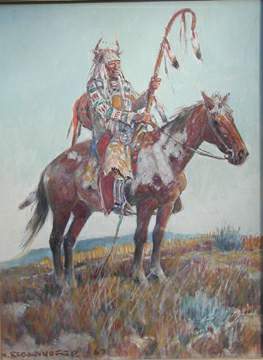
Watercolor 12 x 9 in.
Medicine Man by Nick Eggenhoffer
Nick Eggenhofer, hailing from Gauting, Bavaria, is celebrated as a renowned painter whose work predominantly captures the romance and essence of the American West, replete with its iconic imagery of cowboys and Native Americans. His distinct reputation for historical accuracy is a direct result of his assiduous research, making him a recognized authority on the topic of frontier western transportation.
The seeds of Eggenhofer’s fascination with the American West were sown during his formative years, primarily through stories of Buffalo Bill’s Wild West Show in Germany, shared by older relatives who had been fortunate enough to witness the captivating performances. This intrigue found further nourishment through American western cinema, ultimately propelling him towards a lifelong devotion to the subject.
In 1913, at the tender age of sixteen, Eggenhofer embarked on a life-altering journey to the United States, relocating with his family from Germany. Three years later, he enrolled in evening art classes at Cooper Union in New York, dedicating himself to this pursuit for a commendable four-year period. In the daytime, his education continued as he delved into the realm of lithography at the American Lithography Company, an establishment known for grooming a multitude of accomplished artists.
Subsequently, he established his own illustration studio in New Jersey, which served as the epicenter of his livelihood. As a commercial artist, he lent his artistic talents to the illustration of countless western magazines and books throughout the 1920s to the 1940s. An aficionado of the American West, Eggenhofer expanded his passion by amassing an impressive collection of western artifacts, including saddles, firearms, and indigenous paraphernalia. His talents extended beyond visual artistry, as he also penned and illustrated the comprehensive tome “Wagons, Mules, and Men: How the Frontier Moved West.” This notable work meticulously chronicled the history of pack animals, wagons, carts, and stagecoaches that played pivotal roles in the transportation of people on the western frontier. Furthermore, his dedication to preserving the legacy of the American West saw him craft a series of ten scale models of Conestoga Wagons for the Whitney Gallery of Western Art in Cody, Wyoming.
In a pivotal shift during the 1960s, Eggenhofer undertook a geographical relocation, bidding adieu to his abode in West Milford, New Jersey, in favor of Cody, Wyoming. It is a town bearing the name of Buffalo Bill Cody, the very showman whose spectacles first ignited the flames of his lifelong passion for the rich tapestry of western life.